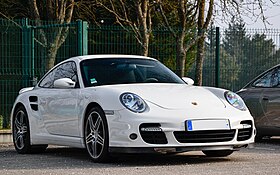| Porsche 997 | |
|---|---|
 Porsche 997 Turbo | |
| Overview | |
| Manufacturer | Porsche AG |
| Also called | Porsche 911 Porsche Carrera |
| Production | July 19, 2004–2013 |
| Assembly | Germany: Baden-Württemberg, Stuttgart |
| Designer | Grant Larson (2001) |
| Body and chassis | |
| Class | Sports car (S) |
| Body style |
|
| Layout | Rear engine, rear wheel drive / all wheel drive |
| Related | |
| Powertrain | |
| Engine |
|
| Transmission | 5-speed automatic 6-speed manual 7-speed ZF 7DT-series PDK |
| Dimensions | |
| Wheelbase | 2,350–2,360 mm (92.5–92.9 in) |
| Length | 4,430–4,496 mm (174.4–177.0 in) |
| Width | 1,808–1,852 mm (71.2–72.9 in) |
| Height | 1,270–1,325 mm (50.0–52.2 in) |
| Chronology | |
| Predecessor | Porsche 996 |
| Successor | Porsche 991 |
The Porsche 997 is the sixth generation of the Porsche 911 sports car manufactured and sold by the German automobile manufacturer Porsche. It was sold between 2004 (for the 2005 model year) and 2013. Production of the Carrera and Carrera S coupé began in early 2004, and the all-wheel drive Carrera 4 and Carrera 4S began to be delivered to customers in November 2005. Deliveries of the Turbo and GT3 derivatives were carried out in late 2006, along with the GT2 in 2007. In addition to the coupé and cabriolet versions, Targa versions of the Carrera 4 and Carrera 4S were also available, which continued the trend of the "glass canopy" roof design used since its first application in the 993 until the 991 generation. This was later reverted to the classic targa top layout used in earlier models of the 911 Targa.
The 997 was an evolution of the preceding 996, with significant changes being made to the interior and exterior styling (the most notable of these being the replacement of the "fried egg" headlamps used in the 996 with the classic "bug eye" units). Larger 18-inch wheels were fitted as standard, and other engineering changes include slightly increased power; however, the car is technically very similar to its predecessor despite many revisions. A new S version was offered, with additional power from a slightly larger engine, a sports suspension, and sports exhaust.
During 2009, Porsche refreshed the 997 lineup, making styling changes, incorporating a new engine with direct injection, and introducing the company's new "PDK" dual clutch transmission. As a result, the refreshed 997 models were faster, lighter, and more fuel efficient than the outgoing versions, with improved handling. In the case of the 997 Turbo, a comprehensively re-tuned all wheel drive system with ”torque vectoring" as an option was also a part of the upgrades package; in an October 2009 preliminary review, Car and Driver magazine estimated that when equipped with the PDK transmission, the updated Turbo should be capable of accelerating from 0–97 km/h (0–60 mph) in three seconds.[citation needed]
The 997 received mostly positive reviews from the worldwide motoring press; even British motoring journalist Jeremy Clarkson, a known detractor of Porsche cars,[1] remarked that the 997 will "make love to your fingertips and stir your soul."[2]
- ^ Clarkson, Jeremy (January 2010). "Jeremy Clarkson on: the Porsche 911". Top Gear. Retrieved 23 February 2019.
- ^ Clarkson, Jeremy (March 2005). "Porsche 911". TimesOnline. London: The Times. Archived from the original on 22 May 2010. Retrieved 26 August 2009.